The Shanghai Express at the ITC Grand Central, Lower Parel has reached its terminus at Beijing and will halt there till June 9, 2019.
The ITC at Lower Parel will hold the last part of its five major Chinese Cuisine experience and host the famous Beijing Cuisine for the next ten days from May 30th to June 9th, 2019. Their far east restaurant The Shanghai Express will serve authentic Beijing dishes especially prepared by Master Chef Jia for their menu.

Beijing or Mandarin cuisine is one of the five major cuisines of China. It is distinct from the Szechuan, Hunan, Canton and Shanghai cuisines in that, that it is the cuisine greatly influenced by Beijing being the capital city and therefore the political hub of the country for the last eight hundred years.
Each dynasty, whether native Chinese or from the surrounds, added to the fascinating imperial cuisine; wolf’s and swan’s meat by the Mongol Yuan Dynasty! The Court of Persia, which took refuge when fleeing from the Arab Aggression also had a lasting influence on the kitchens of the Imperial Court. ‘Shaobing’, a baked, flat bread, hot pots and grilled and sliced meats would be a good example.
Beijing is the cuisine from North of China with its variant served throughout the Northern region. The geographical location and its extreme climate —too hot, too dry, too cold — and surrounding hills made it incumbent on the cuisine to exclude, until very recently, fresh foods like fruits, fish and vegetables. Art of Pickling and Preserving foods developed.
The pollution of a well populated capital did not help! So originally and necessarily, staples were maize, sorghum and buckwheat not rice or wheat. Over the years Wheat, Soya, Vinegar, Maize were introduced and in the last eight hundred years the cuisine of Beijing has changed tremendously. Interestingly there is a ‘Beijing Cabbage’ —- a cabbage grown in the orient which unlike the cabbage known to us does not have a compact cluster of leaves at its heart, cylindrical in form, pale leaves with large crisp base.
Pork meat, and in Muslim habitats, beef or mutton and of course the Imperial Court added exotic fowl (Duck/Swan/Chicken) to its cuisine. Beijing flavours its food with coriander, ginger, garlic, scallions, wines and soy.

The Shanghai Express is serving two varieties of set Beijing meals— @ Rs. 1500 per person and Rs. 2000 per person. Both tickets avail the customer one soup from a choice of 2 vegetarians and 2 non-vegetarian; one main dish from a choice of four vegetarian or four non-vegetarian; one noodles or rice again, from a choice of two noodles/rice and one out of a choice of two deserts.

The more expensive Rs. 2000 per person meal has one Appetizer added on from a choice of four vegetarian and four non-vegetarian.

My friends and I tried the Peking duck and mushroom soup— mild, smooth and laden with little cubes of Duck meat accompanied by Mala Xia — huge tiger prawns in mala sauce, fried to a crisp and chilly hot! Beijing Kaoya Juan — Peking roast duck rolls with pickled cucumbers thrown in for a sweet and salty taste and the vegetarian Haricot beans tossed with dry chilli and Chinese YACA.
THE quality of their lamb, both in the appetizers and the main dishes was as always excellent and delicious when cooked by Chef Jia. The cutely named Pixie Jiding gentle smooth and mild on the palate — chicken in a beer sauce. All in all, the meal was worth spending time over and value for money!
The Aiwowo (a steamed croquet of stewed walnuts and raisins in a sweet sauce covered in rice flour and shredded

coconut) was unique amazingly delicious and to die for. The nut and dry fruit stuffing was reminiscent of the flavours of Khubani Ka Meetha and yet with a distinct Chinese bent.
Obviously, camels’ humps, apes’ lips, bears’ paws, preserved exotica like birds’ nests (edible nests of swifts) and sea cucumbers of the Imperial Cuisine are a thing of the past. Beijing Cuisine in the modern times is a sophisticate set of dishes delicious and very appealing to the Indian Palate.
]]>
The ITC Grand, Lower Parel, will continue to have the Shanghai cuisine at its Far East restaurant the Shanghai club Express from 25 April to 4th of May.


The Shanghai Club Express at the ITC Grand, Lower Parel, has traveled through the Szechuan, Hunan and Canton Provinces and arrived at last at the Province of Shanghai.

The next 10 days, the ITC Grand has Shanghai Cuisine as its main menu. Buy your ticket for Rs. 2000 or Rs. 1500 and enjoy a four/five course meal as per your purchase. Rs. 2000 + Taxes per person avails a First Class meal with five courses—starters are added on to The ‘Superior’ menu (Rs. 1500)— 4 vegetarian, 4 non-vegetarian. (Menu at bottom of page).
Despite being a confirmed non-vegetarian, my two favourites that emerged were the Crispy mix vegetables in Chili Honey Sauce and the complex flavours and fresh colours of Vegetable fried rice with Basil in Chef Jia’s style.

West Lake Sea Food Soup
Shanghai, the Paris of the Orient, is the commercial capital of China; its port is a major Maritime and an Administrative base. With the increase of sea trade in the nineteenth century, Shanghai grew steadily in its size and economics to reach its present day skyline.
Alongside, its migrant community grew too, amalgamating and adapting its own cuisines with the original Shanghai methods of cooking. Thus substantively changing the traditional ‘Benbang’ cuisine of Shanghai— making it more complex—introducing the West Lake Carp from the nearby Hangzhou or vinegar from Zhejiang its western neighbor or Shaoxing contribution of Warm Rice Wine.

Today, Shanghai cuisine is known for accentuating the original flavours of the high quality raw components and condiments which come together to bring about a light, mellow and slightly sweet taste unique to the cuisine. Sweet and sour is typical of Shanghai. Harmonious colours, complimentary shapes, emphasizing presentation is a must in Shanghai Cuisine. It uses more rice than wheat products like noodles.
Also called ‘Hu Cuisine’, its colours, taste and aroma make it one of the more popular cuisines in China. The famous Xiaolongbao, Steamed or Fried Pork buns, Steamed Crab, are all part of Shanghai Formal Cuisine. The common man in Shanghai resident eats a sweet soy sauce-based noodles stir-fried with meat or fish rather than cabbage and onions.
The origins of the cuisine trace back to the Ming and Qing dynasties 400 years ago; and yet, it’s the youngest of the 10 major Chinese Styles of cookery.
The Main Menu for the next ten days at the Shanghai Club Express:





Lemon Tart equally yummy

‘Now’ a new Naturals Ice cream Parlour at Juhu Scheme, Mumbai opened by Mr R S Kamath to celebrate 35 years of Naturas Ice Cream; promoted through the public relations agency, YouMe&We Media Services Pvt. Ltd. — Started by Mr. Dipankar Zalpuri and assisted by sibling, Natasha Zalpuri.
 .
.
The Parlour opened with scrumptious new sundaes to titillate the palate of the Juhu Scheme . The Mellow crunchy Ice Apple and Vanilla Sundae and the zany Passion Fruit and Mango both absolutely gorgeous at Rs. 140 a piece . Not to forget the gorgeous Sundae with all the available flavours at Rs. 500 and a sundae with four flavours @ Rs. 260. The absolutely gorgeous milkshakes — Vanilla and Kesar-Pista . (See Menu at top of Page)


The Parlour opened with a brilliant Laser Show .





NOW is a parlour with a difference. Several different flavours will be churned in vats right there at the counter before the customers. Each VAT will serve about 50 customers. My favourite of the seven flavours was the double scoop of the Roasted Almonds and Tender Coconut.
NOW has this lovely Garden Restaurant in which to enjoy your ice cream treats and milk shakes.



Arty sitting in the garden restaurant

An absolute ‘must visit again and again’.


A unique culinary voyage , a delectable luxury dining experience that braces’ quality with accessibility, Shanghai Club is a discovery. The restaurant showcases a perfect blend of ancient Chinese tradition along with contemporary décor with touches of the symbolic red colour to emphasize upon the Chinese ambiance.

Like we experience in India, Chinese Cuisine too varies almost every hundred miles or so. There is the Szechuan, Hunan, Cantonese, Beijing, and Peking with umpteen other variations in between.
Cantonese cuisine, originally known in China as Guangdong Cuisine, is often referred to as Yue cuisine. This is the cuisine of China’s Guangdong Province, and more specially adheres to its Capital, Guangzhou. Cantonese is a Cuisine with a mild taste, the Cantonese enjoy the natural flavors of fresh sea fish and Sauces, including hoisin sauce, oyster sauce, plum sauce, sweet and sour sauce, and soy sauce. the flavours are well balanced and not greasy. To leave intact the flavours of the primary ingredients, which are at the peak of their freshness and quality, very little few and very little spices are used. The spice does not engulf the natural flavor of the main ingredients. Except the use of garlic and coriander, in order to retain the taste and flavours of the main ingredients, the Cantonese avoid the use of fresh herbs as against the liberal use of the same in Sichuanese, Vietnamese, Lao, Thai and European. In fact, garlic is often used as a vegetable in Cantonese cooking!
This makes Cantonese a popular cuisine in China and Cantonese Chefs are highly sought after in China. Chef Jia brought to India by the ITC being one of them. As required, he uses a variety of cooking methods from roasting, steaming to stir frying.

Cantonese cuisine, less spicy than the Sichuan and Hunan methods of preparation is yet a flavorful and delicious cuisine; far more delicate than other eight forms of Chinese food.
these 10 days at the Shanghai club Express traces the Cantonese route through two set menus – the Superior ticket and a First class ticket on The Shanghai Express. the Superior ticket @ Rs.1500 per person + taxes, avails the diner a four course meal including soup and dessert.
A soup from the choice of four—two pure vegetarian and 2 non-vegetarian. Our Jain friends had their choice too.
One main course from a choice of 4 vegetarians (including for Jains), 1 fish, 1 prawn, 1 lamb, 1 chicken. The Sliced Lamb in chili oyster Sauce paired with Guangzhou Glass Noodles from the vegetarian Menu was YUMMY! So was the enchanting flavours of Wok tossed noodles with pickle vegetables, Asparagus in Chili garlic sauce, Steam tofu in special hot black bean sauce, crispy baby corn salt and pepper at Shanghai Club.
One Noodles/rice from a choice of 3 vegetarians and 3 non-vegetarian.
One dessert from a choice of three. Apricot honey rice pudding with a sprinkle of Pista and julienne of Apricot, highly recommended.
The FIRST CLASS ticket is available for Rs. 2000 and the menu includes a choice of 4 Vegetarian and 4 N0n-vegetarian starters


The Cantonese experience will soon be followed by Beijing and Shanghai destinations on THE SHANGHAI CLUB EXPRESS.
So book your tickets now to experience delicately balanced flavours of yin and yang, dished out by Master Chef Jia.
]]>————- By Conservation Architect Sanaeya Vandrewala.
In light of the latest inscription of the Victorian Gothic and Art Deco ensemble of Mumbai into the UNESCO World Heritage List and in-keeping with the theme of the previous articles about contribution of Parsis to the growth of India and Bombay as a financial capital listed below are the buildings with either contributions of Philanthropic Parsis or designers of these superlative structures that constitute the World Heritage Site.
By the end of the 17th Century, mercantile communities were encouraged to settle to assist in the rise of Bombay city with assurance of religious freedom, liberty to trade and build homes. At the very beginning of the rise of Bombay, this laid the foundations for the city’s cosmopolitan character and robust financial strength. Among the first communities to settle were Gujarati Banias, Brahmins from Salsette, Parsis, and Armenians. These new communities added to the local population of Kolis, Bhandaris, Agris, Prabhus who were domiciled since the 13th century. By the end of the 18th century, a large population of Parsis had migrated towards Bombay. Parsis had merged with the Indian life and were doing well in various trades and businesses. By 19th century Parsis had become the foremost figures in Bombay establishing the first business houses in the country, they emerged at the local, district and regional level with social and economic gains that were elite based. Thus by the 20th Century Parsis along with other communities they played a major role in making Bombay the richest and the most important industrial and commercial center of India.
Bombay’s historic architecture was built on the foundations of public subscription, entrepreneurship, and philanthropy. Parsi industrialists and entrepreneurs, Hindu and Jain bankers and traders, Muslim and Baghdadi Jewish merchants, Armenians, Salsette Christians and English invested in the future of this emerging city, contributing to the urban landscape during the rise of Bombay.
With the cotton boom in the wake of the American Civil war and the opening up of the Suez Canal, Bombay emerged as a global port city in the 19th century. The demolition of the fort walls in the 1860s created a vast expanse of open space for the once fortified town, giving the British an opportunity to implement an ambitious urban design scheme to position Bombay as Urbs Prima in Indis, ‘the first city of India”, and second only to London in the vast British Empire.
- Convocation Hall, University Complex – Designed by Sir Gilbert Scott this is the most magnificent
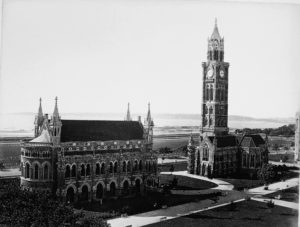
An archival image showing the Rajabai Tower and Convocation Hall, Bombay University architectural complex in the city. Sir Cowasjee Jehangir with a hefty donation of Rs. 1 lac to the total budget of Rs. 4 lacs generously contributed to the construction of this beautiful Venetian Neo-Gothic structure standing steadfast since 1874 facing the Oval Maidan.
- Elphinstone College – Designed by Khan Bahadur Mancherjee Murzban in a Neo-Romanesque style meant to house the Government printing press later was inaugurated in 1888 to house the Elphinstone College and State Archives, illustrious alumni including Sir Pherozeshah Mehta, Dadabhai Naoroji, Bhulabhai Desai, Dr. Bhimrao Ambedkar to name a few. A generous amount was collected by public subscription which had a huge sum contributed by Sir Cowasjee Jehangir.
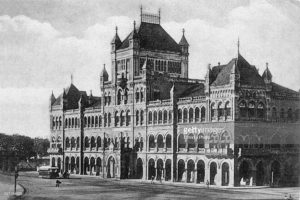
vintage photo-Elphinston College Bombay.
-
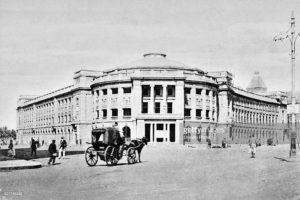
vintage photo-Institute of Science Bombay; present day Cawasjee Jehangir Hall Sir Cowasjee Jehangir Hall-National Gallery of Modern Art – Designed by the George Wittet, consulting Architect to Government of India who also designed the Gateway of India and Prince of Wales Museum, the Cowasjee Jehangir Hall stands in the crossing of two major roads whose foundation was laid in 1911 but the building was only opened in 1920 due to the outbreak of the World war in 1914. Designed in Renaissance Revival style the hall is an impressive 100 feet in diameter, housing the National Gallery of Modern Art since 1996 also built with a huge donation from Sir Cowasjee Jehangir.
- Jehangir Art gallery – Built-in 1950’s with funds from Cowasjee Jehangir family, the gallery was first of its
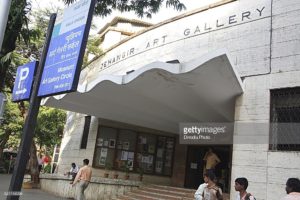
Horizontal Architecture Jehangir Art Gallery Bombay Mumbai Maharashtra India kind in the Kala Ghoda art district. Till date, the pavement plaza outside the gallery provides a platform for budding artists to showcase their art.
5. Regal Cinema – Designed by Charles Steven, son of Frederick William Stevens (famous for designing Victoria Terminus, Municipal Headquarters, Royal Alfred Sailors Home etc) was constructed in 1934 in Reinforced Cement Concrete and was one of the finest theatres in the city of Bombay owned by Globe Theatres Company of K.A. Kooka and F. H .Sidhwa. With interior murals designed by an expatriate Czechoslovakian, Karl Scahara, it is the finest Art Deco examples in the city.


6. Eros Cinema – Funded by entrepreneur Shavak Cambatta and designed by Sohrabji Bhedwar, constructed in the Art Deco style, Eros Cinema was inaugurated in 1938 and was the final word in style and elegance.
7. Several Art Deco buildings of the Backbay Reclamation Scheme completed in 1930’s built on the other side of Oval Maidan opposite the University Complex and along the Marine Drive had Parsi Architectural firms as designers to name a few, Contractor & Kanga, P.C. Dastur, Merwanjee & Bana, Mistri & Bhedwar, K.P. Daver etc and many of them had Shapoorji Pallonji as the Contractors.
To know more about the Mumbai world heritage site, heritage walks are conducted in the heritage precincts for further information or for private, customized tours please contact on email address heritagewalksmumbai@gmail.com or visit our facebook page https://www.facebook.com/MumbaiHeritageWalks/
Bibliography:
http://whc.unesco.org/en/list/1480/ for Mumbai’s inscription
Dwivedi, S and Mehrotra, R (1995) Bombay- The Cities within. Mumbai: Indian Book House Pvt. Ltd.
Dwivedi, S and Mehrotra, R (1999) Fort Walks. Mumbai: Eminence Designs Pvt. Ltd.
Photo credits- Getty Images
Note: Formerly known as Bombay in English, the name of the city was later adapted from its indigenous term in the state language Marathi into English in the year 1995 to be know called as
]]>

 knew what they can really do and how swiftly these Combat Engineers work to facilitate the very survival of our army on the move on the the battlefield; The high speed at which they work to provide mobility to the armed forces, how rapidly they build and dismantle tracks, helipads and bridges and how fast they create obstacles for the enemy by laying mine fields and demolishing bridges once our own forces have passed that way.
knew what they can really do and how swiftly these Combat Engineers work to facilitate the very survival of our army on the move on the the battlefield; The high speed at which they work to provide mobility to the armed forces, how rapidly they build and dismantle tracks, helipads and bridges and how fast they create obstacles for the enemy by laying mine fields and demolishing bridges once our own forces have passed that way.Bombay Sapper, a soldier responsible for engineering tasks and laying and clearing mines. In the British Army, a private soldier in the Corps of Royal Engineers, a combatant performing various feats of military engineering, also trained as an infantry man in operations, both defensive and offensive.
In India, we have informally, the Bombay Sappers, the Calcutta Sappers In Lonavla some twenty years ago I had met Retd. Colonel BSKS Chopra. he was a Bombay Sapper from Kirkee (Head Quarters of the regiment.), “ it is a support group, it follows the army and helps set the infrastructure when and where needed …”
Infrastructure? I thought. “ Let’s say, the besieging forces come to a chasm or a river and there is no existing cross-over, the Sappers immediately build a bridge with whatever materials are available”, he explained
Hmmm …I thought again. With whatever material available?! They must be quite something and the immediacy?! And the quality of work! It wouldn’t do for the besieging forces or the besieged ones at that, to plunge head long into a raging torrent or the rolling jeeps and tanks to drop into the chasm a few hundred feet below, now would it?

It all started in the late seventeenth century with the French soldiers who
sapped. Soldiers were used to destroy enemy fortifications by using ‘sape’ meaning, ‘trenches’. Those engaged with ‘Mines’ (tunnel war-fare )were called Miners. Sappers dug trenches to allow attacking forces to advance towards the enemy defense works and forts until the besieged would be sufficiently suppressed for the attackers to breach the walls. Often the sape was dug up to and under the fort wall. Then, a tremendous gun-powder explosion was engineered which would destroy the besieged fort wall and permit attacking infantry to breach the enemy lines.
India received its ‘Sappers’ a century later with a new force imprinting its mark 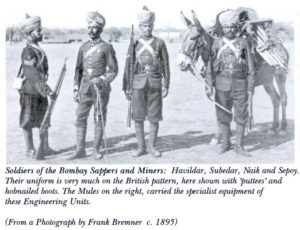 on the politics of India. A hundred Indians became Sappers when in 1777, the Bombay Presidency’s first Chief Engineer, Major Lawrence Nilson, recruited them to form the ‘Pioneer Lascars’. Even today, the Sappers are often referred to as ‘Pioneers’. Come 1797, under Captain-Lieutenant Bryce Moncrieff (Bo.E.), the Pioneer Lascars were absorbed into newly formed four Companies of 100 men each, rendering sterling service in maintaining lines of communication and assisting the heavy cannons reach battlefields. Twenty five years later, in 1822, they officially became a battalion.
on the politics of India. A hundred Indians became Sappers when in 1777, the Bombay Presidency’s first Chief Engineer, Major Lawrence Nilson, recruited them to form the ‘Pioneer Lascars’. Even today, the Sappers are often referred to as ‘Pioneers’. Come 1797, under Captain-Lieutenant Bryce Moncrieff (Bo.E.), the Pioneer Lascars were absorbed into newly formed four Companies of 100 men each, rendering sterling service in maintaining lines of communication and assisting the heavy cannons reach battlefields. Twenty five years later, in 1822, they officially became a battalion.
For their exceptional service in the “Great War”, the title ‘Royal’ was bestowed on the Corps in 1921, making them the ‘3rd Royal Bombay Sappers and Miners’. Two years later, the Corps became the ‘Royal Bombay Sappers and Miners’ and remained so, till the end of the Second World War.
Most nations of the world have their Sappers and Miners. In France, where the name originates, has both civil and military ‘Sapeurs’. They have the Sapeur de l’Air (Air Sapper) , Sapeur Parachutiste (Parachute Sapper), Sapeur de Marine (Marine Sapper), Sapeur-mineur (Sapper-miner )and the municipal Sapeur-pompier( Fire-fighters).
Not to be outdone, Portugal has ‘Sapador de Engenharia’ (engineering sapper) , trained combat engineers, ‘Sapador de Infantaria’ (infantry sapper) soldiers who usually serve in the combat support sapper platoon of an infantry battalion, ‘Sapador NBQ’ (NBC sapper) engineers specialized in Nuclear, biological and Chemical war-fare. Municipal Sappers The ‘Bombeiros-sapadores’ (Sapper-firefighters).
Greece, ‘μηχανικό; michaniko’ (Corps of Engineers) , the Italian Army has ‘Guastatore’ combat engineers and other specialized sapper units ; the United States Army, sappers are combat engineers who support the front-line infantry. Ottoman Empire, ‘Lağımcılar Ocağı’ (literally: Sapper Corps) and the Pakistan Army, sapper officers like in ours, perform combat and normal engineer duties. Canada, in honour of sappers who graduated from the Royal Military College of Canada, has named an island in St. Joseph Channel, Algoma District, Ontario as the Sapper Island.

]]>
The Renaissance at Powai is hosting a fish festival ‘Flavours of the Coast’ Festival every night from7 pm on wards, till October 8, 2017. We called phone no. 66928888 for the information we needed.
On September 30, 2017, the opening day of the festival, The Renaissance at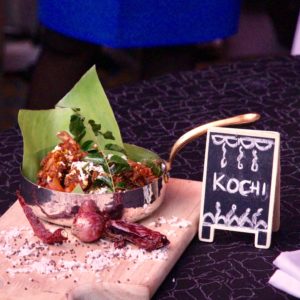 Powai invited a few guests to cook along with the 6 specialty Chefs from the various Marriott Hotels along the shores of the Indian Peninsula. Renaissance had laid out 6 tables; one for Mumbai , one table for Goa, one table for Bangalore, one table for Kolkata , one table for Kochi and one table for Tamil Nadu covering the cuisine of the 7,517 kilometer coastline of India . The specialty Chefs were to guide and merely guide the guests in producing the coastal fish specialty dish.
Powai invited a few guests to cook along with the 6 specialty Chefs from the various Marriott Hotels along the shores of the Indian Peninsula. Renaissance had laid out 6 tables; one for Mumbai , one table for Goa, one table for Bangalore, one table for Kolkata , one table for Kochi and one table for Tamil Nadu covering the cuisine of the 7,517 kilometer coastline of India . The specialty Chefs were to guide and merely guide the guests in producing the coastal fish specialty dish.
Under Sous Chef Dinesh Kumar’s (from Chennai) guidance, my friend Vera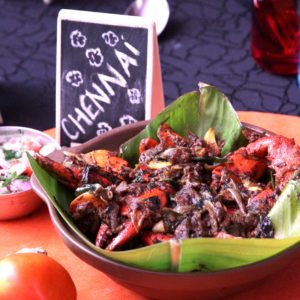 Pavri and I emerged winners of a proud bottle of wine and chocolates for the ‘Mangalore Fish Curry’ that Dinesh guided us through.
Pavri and I emerged winners of a proud bottle of wine and chocolates for the ‘Mangalore Fish Curry’ that Dinesh guided us through.
In the recipe menu of this blog, I have shared the quick and easy but absolutely delicious recipe with you.
Even if I say so myself, the curry was so well balanced in its flavours that, the judges voted ours the best dish and Vera, Dinesh and I walked off proud owners of a bottle of wine and a delicious box of chocolates.
Nicholas Dumbell, the General Manager, at the Renaissance of the hotel thought the sauce was really good but liked the Kochi Chicken the most. Chef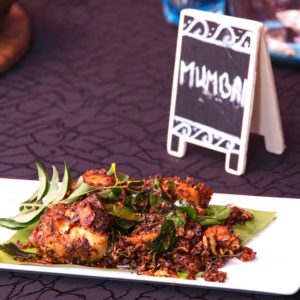 Sahil Arora one of the judges, an Executive Chef at the Renaissance, went “Wwow!” with the first taste of our red snapper Mangalore curry. Both judges Arora and Anshuman Bali (Executive Chef, Sahar Marriott), ate a few more spoons of it amidst a lot of ribbing and to our great joy — a tacit encomium to Chef Dinesh Kumar’s prowess. As Swapna Vora a food critic present there said,” they are eating some more! You know, it is so difficult to get a chef to eat.”
Sahil Arora one of the judges, an Executive Chef at the Renaissance, went “Wwow!” with the first taste of our red snapper Mangalore curry. Both judges Arora and Anshuman Bali (Executive Chef, Sahar Marriott), ate a few more spoons of it amidst a lot of ribbing and to our great joy — a tacit encomium to Chef Dinesh Kumar’s prowess. As Swapna Vora a food critic present there said,” they are eating some more! You know, it is so difficult to get a chef to eat.”
Later a number of other hotel staff that tasted all the special fish dishes cooked at the contest found the Mangalore Fish Curry absolutely delicious.
Sous Chef Thirumal from Bangalore, guided the Goa team to cook the Goa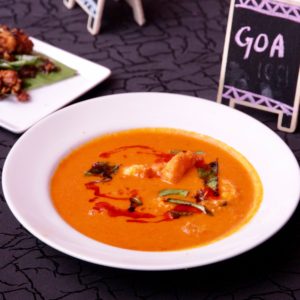 prawn curry (which I thought would win), Sous Chef Laxman from Goa, guided the Maharashtra team to cook a Toddy Chicken from Bombay; Kochi Masala Chicken by Sous Chef Vivek from Maharashtra; Sous Chef Saji from Kochi chose to cook a Mustard Fish Curry for the Kolkata team and Sous Chef Himadri from Kolkata chose to make the Tamil Nadu Fish Curry.
prawn curry (which I thought would win), Sous Chef Laxman from Goa, guided the Maharashtra team to cook a Toddy Chicken from Bombay; Kochi Masala Chicken by Sous Chef Vivek from Maharashtra; Sous Chef Saji from Kochi chose to cook a Mustard Fish Curry for the Kolkata team and Sous Chef Himadri from Kolkata chose to make the Tamil Nadu Fish Curry.
Vera and I were particularly glad we parked ourselves at the table for Bangalore cuisine and that the lottery picked the very pleasant and patient Chef Dinesh Kumar for our guide.
Chef Dinesh Kumar obviously has talent for cooking tasty and well balanced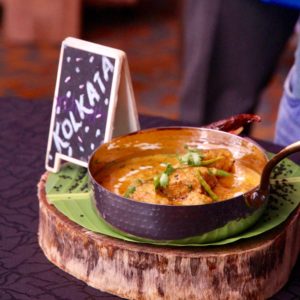 dishes. The Mangalore Fish Curry was not the only dish that Dinesh Kumar turned out with adroit ability. Later, while dinning at the specialty fish buffet dinner we were served chicken curry with Dosa from the Tamil Nadu live station, and it was par excellence. Though I am not one for masala food, I absolutely lapped up the admix of flavours, of hot and sour and the fresh herbs Dinesh had used.
dishes. The Mangalore Fish Curry was not the only dish that Dinesh Kumar turned out with adroit ability. Later, while dinning at the specialty fish buffet dinner we were served chicken curry with Dosa from the Tamil Nadu live station, and it was par excellence. Though I am not one for masala food, I absolutely lapped up the admix of flavours, of hot and sour and the fresh herbs Dinesh had used.
I am informed that, unfortunately with the crowd around the prize- winning dish, the photographer was unable to take a picture of the Mangalorean Fish Curry.
The vast Buffet at the Renaissance Flavours of the Coast Festival spoilt its customers for choice. Soups, Salads, live stations (one each for the entire Indian Peninsula), European including Italian cuisine, live fish station with baby lobsters, prawns, pomfret, shark and other fish for you to choose and cooked to your specifications. Not to forget, the varied Indian flavours of the coast counter which had the chingri masala an absolutely delicious prawn dish from Calcutta, the pepper roast from Goa the various vegetable stews and other lesser known, but delicious, dishes.
Followed by a vast array of desserts; including, but not confined to Cake and Ice creams. Cheese, Crackers, and Nuts, make this a ‘must visit’ for all gourmands.
Don’t miss the Flavours of the Coast festival ….and remember to ask for visiting Sous Chef Dinesh Kumar!
]]>Whether it was the ‘C’Remember Mumbaikar’s favourite ride in his favourite BEST Double Decker bus all the way to R C Church.what better way to start this ‘peep into the past’ pictorial journey of Mumbai transport system.
THIS IS HOW IT ALL BEGAN:

BEST, originally in 1873 the “Bombay Tramway Company Limited” (under an Act of the Bombay Presidency), ran Horse-drawn Trams.To run its later electric trams, it set up in 1905, a captive power station at Wadi Bunder with a 4,300 kilowatts (5,800 hp) steam-power generator. This led to it supplying electric power to the city of Bombay; and so was born the’ ‘Bombay Electric Supply & Tramways (BEST) Company’. The BEST bought the assets of the tram-way company for Rs.9, 850,000.

The year 1916 saw the rise of the private enterprise when The Tata PowerBest Gas Lamps before 1907 Company started to supply electricity to the Tram-way in 1916 and by 1925 all power was bought from and supplied by Tatas.

Growing city Bombay already faced rush-hour traffic in these  early years and the Tram-way company introduced Double Decker Trams to ease the problem. None survived to my lifetime, though I recall travelling by trams in my childhood and then by the trolley bus from Gowalia Tank to Grant Road.
early years and the Tram-way company introduced Double Decker Trams to ease the problem. None survived to my lifetime, though I recall travelling by trams in my childhood and then by the trolley bus from Gowalia Tank to Grant Road.

The next avatar of the BEST in 1926 brought Motor-Transport-Buses to Bombay and finally in 1947 it became the ‘Bombay Electric Supply & Tramways (BEST) Company’. Today, since 1995, Mumbaikars know it as “Brihanmumbai Electric Supply & Transport (BEST)”
Before 1865, Bombay had no mass public transport system. An enterprising American company decided to run horse drawn trams in the city and applied

for and was granted a licence; but the “Bombay Omnibus Service” never took off as the fare was exorbitant– service between Malabar Hill and Fort would cost a pass- fare of THIRTY POUNDS a month in the 1860s!
Then, on May 9th, 1874, Bombay saw its first horse-drawn tram at a princely fare of THREE ANNAS (in today’s terms Paisa Fifteen) plying the two routes from Colaba to Pydhonie via Crawford Market and from Bori Bunder to Pydhonie via Kalbadevi. As the travel mode became popular, the fare REDUCED TO TWO ANNAS (6 paisa to an anna). Stearns and Kittredge stabled 900 horses for the Tram Service.
It speaks a lot for the trustful naivety of the fledgling company that NO TICKETS were issued. It soon learnt, and later that year tickets were introduced to discourage ticketless travel. Sounds familiar? Old habits die hard!
The rest of the journey in pictures:











 ‘CERITA’ CNG
‘CERITA’ CNG
 MARVE FERRY of BEST
MARVE FERRY of BEST
Thus, continues the story of the BEST BUSES through the years
]]>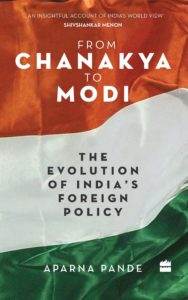
Indian Foreign Policy–an overview by Aparna Pande, Director of the Initiative on the Future of India and South Asia, at Hudson Institute, Washington D.C.
Want to dispel the opinions and views formed on rumours and personal tales about the way India deals with its neighbours and the world? Read the evolution of the India’s Foreign Policy in the book ‘FROM CHANAKYA TO MODI’, by Aparna Pande. and student from Stephen’s College, University of Delhi, JNU and Boston University,
India’s foreign policy like that of “Every country’s foreign policy, has an underlying paradigm that explains what has influenced its policy and why that country takes its own unique stand. This paradigm is the product of the nation’s history and its view of self. Leaders, especially those in premier positions for long periods, also shape how a nation sees itself in relation to others”, says Aparna
Aparna Pande’s new book, launched last week at a function at the Observer Research Foundation on August 5, ,traces the evolution of India’s Foreign Policy all the way ‘From Chanakya to Modi’ today.
It is a book that Aparna has dreamt of writing for a long, long time and a book that we as individual citizens of India have wanted to read for an equally long time: factual, intelligent, and objective elucidation of India’s position on the globe and in the Global Political World; the events, circumstances and people that caused this position and policy—India’s Foreign Policy.
A book that explains India’s foreign policy to the world and to its people: what are the ideas that have influenced foreign policy, the individuals who have left their mark and the institutions that play and played a role in shaping the policy?
 …And who better than the learned to give us an overview of the Indian foreign policy as shaped from ancient times to the present millennia. Aparna has examined both sides of the border. She had earlier written a treatise on” Explaining Pakistan’s Foreign Policy: Escaping India” (Routledge, 2011), a policy much discussed by every Indian, all the time. She is also the editor of Contemporary Handbook on Pakistan (Routledge, 2016).
…And who better than the learned to give us an overview of the Indian foreign policy as shaped from ancient times to the present millennia. Aparna has examined both sides of the border. She had earlier written a treatise on” Explaining Pakistan’s Foreign Policy: Escaping India” (Routledge, 2011), a policy much discussed by every Indian, all the time. She is also the editor of Contemporary Handbook on Pakistan (Routledge, 2016).
At book launch last week Aparna was impressive; succinct, clear, confident and knowledgeable. Her short but to the point speech left the audience panting for more; surprised at its brevity, richness and precision.
As the name suggests, Aparna’s book starts with the legacy of Chanakya and the ancient philosophers on the India’s Foreign Policy, moving on, to the medieval era of the sultans, through to the much reviled British colonial strategists of the Raj and finally the Indian National Movement for an independent India. According to Aparna, these legacies are still perceptively evident on India’s external relations.
The book lays out four major strands in the contemporary India’s Foreign Policy: Imperialist legacy, Messianic Idealism, Realism and Isolationism.
The ‘Imperial’ school of thought draws primarily from period of the British Raj. For this outlook, India Policy is the central policy and Delhi knows best. India’s post-independence policy towards its immediate South Asian neighbours best exemplifies this idea. Delhi, whether under the British or thereafter, has always believed that India’s central government is best suited to make security decisions.
‘Messianic Idealism,’ reflecting the mantra of global peace, justice and prosperity has served as the strong moral component of India’s foreign policy, inspired by the moral legacy of ancient Indian thought reiterated during national struggle under Mahatma Gandhi. Proponents of this perspective believe that India is an example for the world to emulate and that India has a duty to set such an example.
India has had no qualms in anchoring external relations in ‘Realism’. Belief in moral principles did not turn Indian leaders into pacifists. Notwithstanding the idealism, New Delhi has always recognized the importance of hard power for the success of the State.
Then there is the contradiction of ‘Isolationism’. India has been obvious in its reluctance to be drawn into global issues or ideologies and yet, has always chooses to play a global role. There is this strong streak of ‘isolationism’ in India’s global outlook. It is one of India’s many paradoxes that it wants to be seen as a great power and is still often reluctant to do what is required of most great powers.
Aparna analyzes the what and the why of the foreign policies followed by all the Prime Ministers of independent India – from Jawaharlal Nehru to Narendra Modi; The rationale and raison d’être for each Prime Minister’s policy. Interestingly, Aparna finds that while each Premier tried to walk his own path, there is a remarkable degree of continuity in the policies followed over the independent decades of different governments.
Individuals aside, Aparna details the role of an array of institutions that played a role in formulating and shaping India’s foreign policy— the primacy of the prime minister’s office, the role of ministry of external affairs, parliamentary oversight, the responsibility of the national Security Council, the role played by the media and new actors.
This book by Aparna Pande makes interesting and informative reading for the lay and the cognizant; dispelling rumour and myth that rules the Indian polity and lay opinion.
]]>





